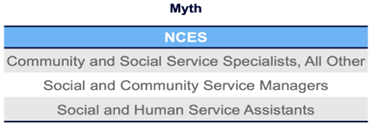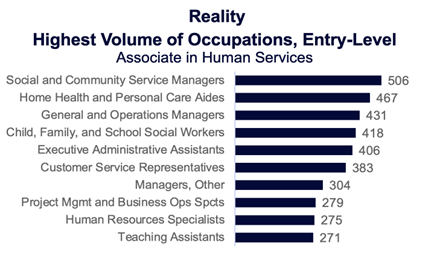
Conventional analyses of employment opportunities for graduates of specific academic programs are deeply flawed. Traditional data sources like the National Center for Education Statistics (NCES) only include occupations for which students are directly prepared (e.g., nursing graduates become nurses). In essence, they only see a fragment of graduates' possible career paths - the tip of the iceberg, if you will. As it says on the NCES website (2020), their crosswalk from academic programs to occupations “is not based on actual empirical data” (para. 1).
The Misleading Narrative
According to NCES (2020), an associate’s degree in human services limits graduates to only three occupations. This narrow view eclipses the diverse career pathways that dedicated students can pursue beyond their diplomas. At Gray Decision Intelligence, we shatter these misconceptions, using data from the census and individual records on millions of graduates to determine what people really do after graduation.

Source: Gray DI Analysis of NCES Data
The Gray DI Difference
With Gray DI’s analysis of People Profile Data, encompassing approximately 30 million alum profiles, our Program Evaluation System offers a revolutionary alternative to common data sources. Our extensive alums database allows us to demonstrate not just the direct-prep job outcomes but the actual career pathways of graduates.
Take, for example, our findings on Associate in Human Services program graduates - a stark contrast to NCES data. Instead of being confined to three avenues, we uncovered that they venture into an astounding 675 occupations across 145 industries and contribute their skills to over 22,060 companies.
Among the top 10 entry-level occupations for these graduates, only one aligns with those listed by NCES. This revelation broadens the career spectrum and shatters the myth about the limitations of community college degrees.

Source: Gray DI Analysis of internal People Profile Data
It's time to acknowledge that each graduate's professional journey is as unique as their individual aspirations and contributions to society. By utilizing Gray DI's PES and expansive insights, educational institutions can gain a deeper understanding of their program's impact, revise their curriculum accordingly, and better prepare students for a robust range of career opportunities that await them.
It’s Time for Action
We urge leaders in higher education to look beyond traditional methods and recognize the immense value that comprehensive data analysis brings. Don't settle for the incomplete narrative. Equip your institution with the analytical power of Gray DI’s PES to illuminate the full spectrum of career outcomes for your graduates.
To truly understand where your students can go, you need to see the whole picture. Discover more about how Gray DI’s PES can help you trace the real-world impact of your community college programs and confidently guide your students toward a brighter, more diverse professional future.
Reference
National Center for Education Statistics. (2020). CIP SOC crosswalk. https://nces.ed.gov/ipeds/cipcode/post3.aspx?y=56
Gray Decision Intelligence was an Innovations 2024 Champion Sponsor.










